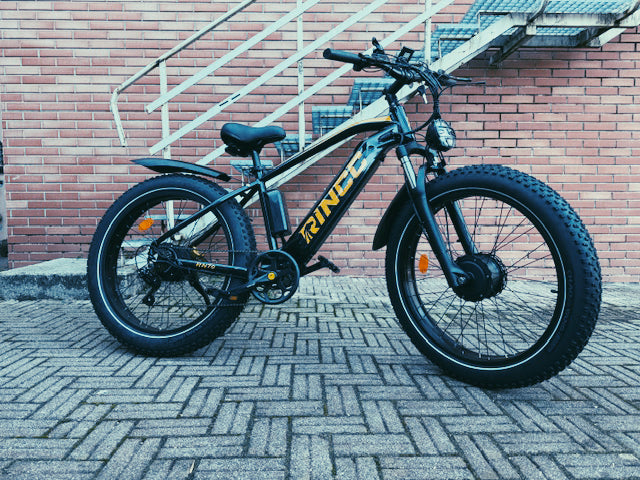Riding your electric bicycle in the rain is entirely feasible, provided you take appropriate precautions. Modern e-bikes, such as those offered by Rincc, are engineered with water-resistant features to ensure reliable performance even in wet conditions. Understanding the waterproof capabilities of your e-bike and adopting safe riding practices can help you navigate rainy weather confidently.
Understanding E-Bike Waterproofing: IP Ratings Explained
The waterproofing level of an e-bike is typically indicated by its Ingress Protection (IP) rating. This rating comprises two digits: the first denotes protection against solid particles like dust, and the second indicates resistance to liquids. For instance, an IPX4 rating signifies protection against water splashes from any direction, making it suitable for riding in light rain. Higher ratings, such as IPX5 or IPX6, offer increased protection against water jets, which is beneficial for those frequently riding in heavier rain conditions .
Understanding Rincc E-Bike Water Resistance
Rincc e-bikes come with a waterproof rating of PX4, equivalent to IPX4, indicating protection against water splashes from any direction. ensuring they can withstand typical rainy conditions without compromising performance.
It's important to note that while the IPX4 rating offers a basic level of water resistance, it doesn't guarantee complete protection against all wet conditions. Therefore, it's advisable to avoid riding in heavy rain or through deep puddles to prevent potential damage to the electrical components.
Riding your bike in the rain requires careful preparation to ensure safety and performance. A thorough equipment check before setting off can make all the difference.
Here's a detailed guide focusing on three critical components: lights, brakes, and tires.
Lights: Ensuring Visibility in Low-Light Conditions
Rainy weather often brings reduced visibility, making it essential for both you and your bike to be seen by others.
Front and Rear Lights: Equip your bike with bright, waterproof lights. A front light with at least 600 lumens ensures you can see the road ahead, while a rear light alerts drivers to your presence.
Reflective Elements: Incorporate reflective materials on your bike and clothing to enhance visibility from all angles.
Battery Check: Ensure all lights are fully charged or have fresh batteries before each ride.
Brakes: Reliable Stopping Power on Wet Roads
Wet conditions can significantly affect braking performance.
Brake Pads: Inspect for wear and replace if necessary. Some brake pads are specifically designed to perform better in wet conditions.
Brake Cables and Levers: Check for fraying or corrosion, and ensure levers engage smoothly.
Test Braking: Before starting your ride, test your brakes to ensure they respond promptly.
Tires: Maintaining Traction and Control
Your tires are the only contact point between your bike and the road, making their condition crucial, especially in the rain.
Tread Depth: Ensure your tires have sufficient tread to channel water away and maintain grip.
Tire Pressure: Check and adjust to the manufacturer's recommended levels. Slightly lower pressure can increase the contact area, improving traction on wet surfaces.
Inspect for Damage: Look for cuts, punctures, or embedded debris that could lead to flats.
Tips for Safe Riding in Wet Conditions
To ensure safety and maintain your Rincc e-bike's performance during rainy rides, consider the following tips:
1. Reduce Speed and Brake Early
Wet roads can reduce tire traction, increasing stopping distances. Slowing down and braking earlier than usual can help maintain control and prevent accidents.
2. Maintain a Safe Following Distance
Increased stopping distances on wet surfaces necessitate a greater distance between you and the vehicle ahead to allow ample reaction time.
3. Use Appropriate Tires and Adjust Tire Pressure
Lowering your tire pressure slightly can increase the contact area with the road, improving grip in wet conditions. However, ensure it remains within the manufacturer's recommended range to avoid compromising the tire's integrity.
4. Wear Waterproof and Reflective Gear
Donning waterproof jackets, pants, and shoe covers can keep you dry and comfortable. Additionally, wearing reflective clothing enhances visibility to other road users during low-light conditions.
5. Enhance Visibility with Lights
Rain can impair visibility. Using front and rear lights ensures you're seen by others, reducing the risk of collisions.
6. Avoid Puddles and Slippery Surfaces
Puddles may conceal potholes or debris. Avoid riding through them when possible. Also, be cautious of slippery surfaces like wet leaves, painted lines, and metal grates.
7. Install Mudguards
Mudguards can prevent water and mud from splashing onto you and the bike's components, keeping both cleaner and reducing maintenance needs.
Post-Ride Maintenance
After riding in wet conditions, it's essential to perform the following maintenance tasks:
Dry the Bike: Wipe down the frame, battery compartment, and motor with a dry cloth to remove moisture.
Lubricate the Chain: Rain can wash away lubrication. Reapply a suitable chain lube to prevent rust and ensure smooth operation.
Inspect Brakes and Tires: Check for wear and ensure tires are properly inflated for optimal traction.
Store Properly: Keep your e-bike in a dry place to prevent prolonged exposure to moisture.
RINCC RN70 electric motor vehicle
Design features: RN70 battery has strong driving force. Suitable for Useong city roads, touring and traveling to Koshino, providing outstanding performance under various weather conditions.
Conclusion
Rincc e-bikes are built to handle light rain, making them suitable for most wet weather conditions. By understanding their water resistance capabilities and following the recommended safety and maintenance tips, you can enjoy a safe and comfortable ride, rain or shine.
For more information on Rincc e-bikes and their features, visit Rincc Official Website:https://rinccbike-eu.com/.


Share:
What Could Cause My E-Bike to Move Backwards by Itself?
Is Overnight Charging Okay for My Electric Bike?